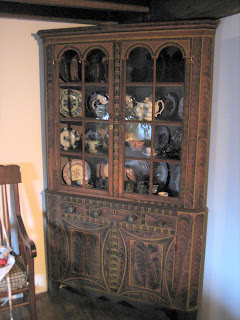 |
| Mennonite Heritage Center |
Keith is actually a former student of mine from eons ago, when I taught in the middle school. He likes all things Pennsylvania German and is going to study their houses and furnishings (and other stuff) at a prestigious school in Philadelphia. He brought his friend Ken, who is an architect. I arrived a little late, having misjudged the time it would take to get there, even with the Box outdoing itself on the Northeast Extension of the turnpike.
 |
| Redware pottery |
Next we took a look at the oil painting exhibit, another with antique fraktur, a third with antique clothing, and finally, the permanent exhibit of Mennonite Church history. A quick stop in the gift shop completed the visit.
 |
| Ken, left, and Keith at Schwenkfelder Library |
Caspar Schwenkfeld von Ossig was a Protestant Reformer in 16th century Europe. His followers, known as Schwenkfelders, settled in southeastern Pennsylvania in the 1730s and still have churches in that area today.
The heritage center exhibits items owned and used by the Schwenkfelders, many of them from the 18th and 19th centuries. The center also tells their story and describes the current six congregations, all of them in the Philadelphia area, with 3,000 members. The Schwenkfelders never adopted a distinguishing form of dress, like the Amish or Mennonite groups did.
In the lobby, there was a sale of crafts by heritage center members, I think, and a small gift shop. Once again, we resisted buying anything. Two ladies inside the door were handing out delicious cookies and attempted to direct us back to Green Lane and Red Men's Hall, where the third Christmas exhibit was taking place. They were both so accommodating and talked over each other so much that I had to step away, fearing a stroke or brain aneurysm, and left Keith and Ken to figure it out.
Soon we headed toward Green Lane, stopping briefly to see a handsome stone house with brick trim and imagining how much better it would look without the aluminum columns and the plastic shutters.
 |
| Red Men's Hall in Green Lane |
We checked out the baked goods and Christmas Market, then climbed a very tall flight of steps to see the general museum, filled with such goodies as iron stoves, a church pulpit, farm implements, home furnishings -- just a very nice collection of old things from the area. Goschenhoppen Historians was formed when local folks realized that the things and activities associated with "the old days" had begun to disappear.
 |
| Chamber organ at Goschenhoppen |
Many descendants of these early settlers live in the community today. Our concerned community members support the Historians in the collection, preservation, and dissemination of the history and folk culture of the Pennsylvania Germans in the Goschenhoppen and nearby areas."
Our final stop there was the General Store, where, with the smell of roasting peanuts wafting through the door, we saw all sorts of items one would find in a store about a hundred years ago. We were met at the front door by an effigy of the Belsnickel, Santa's evil counterpart, who scared kids into being good in the early Pennsylvania German communities.
It was very obvious throughout this visit that the people volunteering at these places were completely devoted to their missions of preserving and sharing their knowledge. While some of the institutions were more sophisticated than others, I really have to commend these folks for their work.
 |
| Don't let the Belsnickel get you! |
As the Philly men headed off to buy a Christmas tree, the Box and I headed back to the northeast extension of the turnpike and arrived home after dark, having fought our way through a huge number of 18-wheelers that liked hanging out in the passing lane.
The museum at the Mennonite Heritage Center.
The Mennonite kitchen exhibit.
Vintage clothing on exhibit.
The art sale items were quite fine.
A beautiful scherenschnitte, or
paper cutting.
Hand-made rugs are colorful.
This woman was demonstrating scherenschnitte.
And this one was hooking rugs.
Back in the museum, the bedroom display.
A fine cupboard houses china.
China on a hutch at the Schwenkfelder Heritage Center.
This jacquard coverlet hung near an antique loom.
This organ (c.1825) must have been for
a home, since organs were not allowed
in Schwenkfelder worship.
Redware!
Schwenkfelder chests made in Germany and
used to travel to the colonies.
Bed, chair, and decorated chest.
Nineteenth century mourning attire.
A child's coffin, filled with ice or herbs for the wake.
It is sitting on a bier for carrying to the cemetery.
The Schwenkfelder Center's putz or Christmas village.
Farm animals are a feature of the putz.
They were serving lunch and selling baked
goods at the Goshenhoppen museum.
Paper chains on a natural tree--
no shearing and shaping here!
A candle "construction" with apples and boxwood.
A branch wrapped with cotton and
decorated with mid-20th century ornaments.
Flag chains on another natural tree.
In the museum, another pipe organ!
A ten-plate stove cast at an iron furnace.
A pulpit and table from an early church.
This decorated hutch held china.
As we left the Goschenhoppen museum,
Ken and Keith try out the door's
Ken and Keith try out the door's
not-so-subtle peephole.






























No comments:
Post a Comment
Your comments are welcome here.